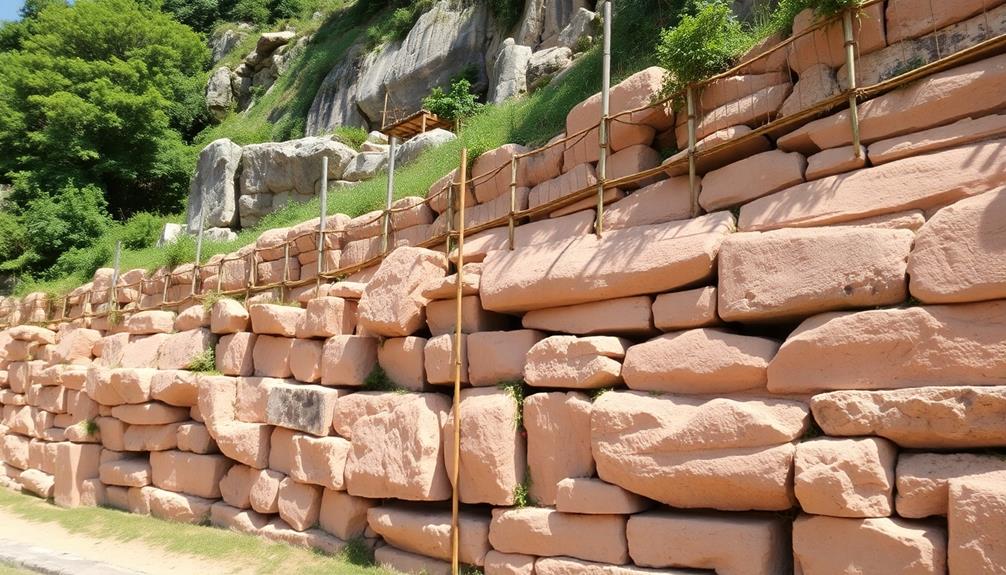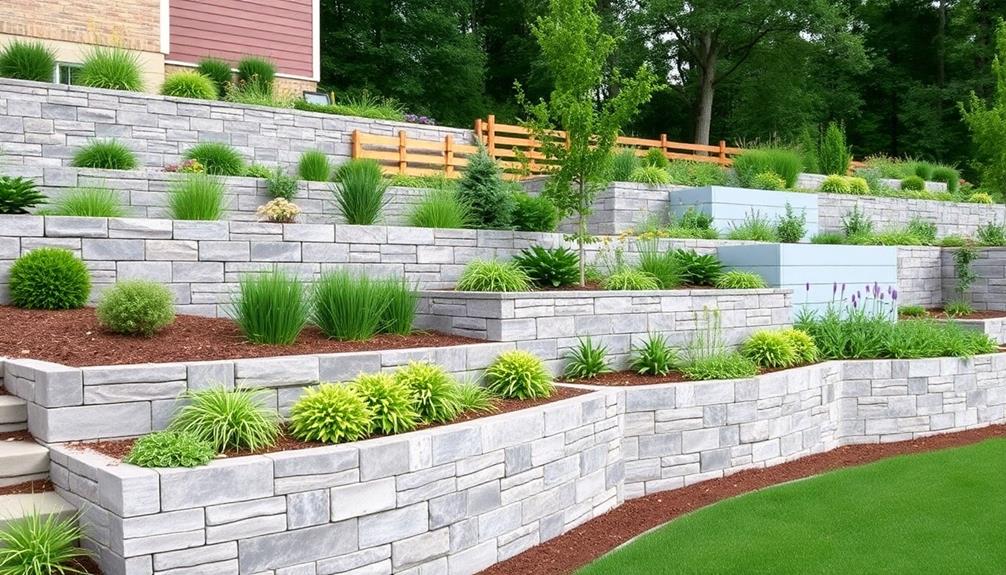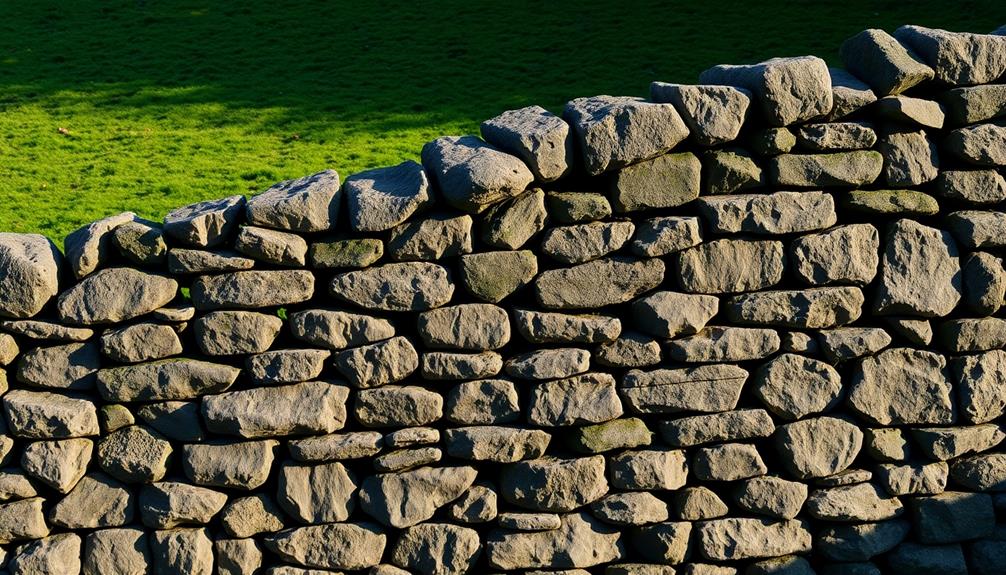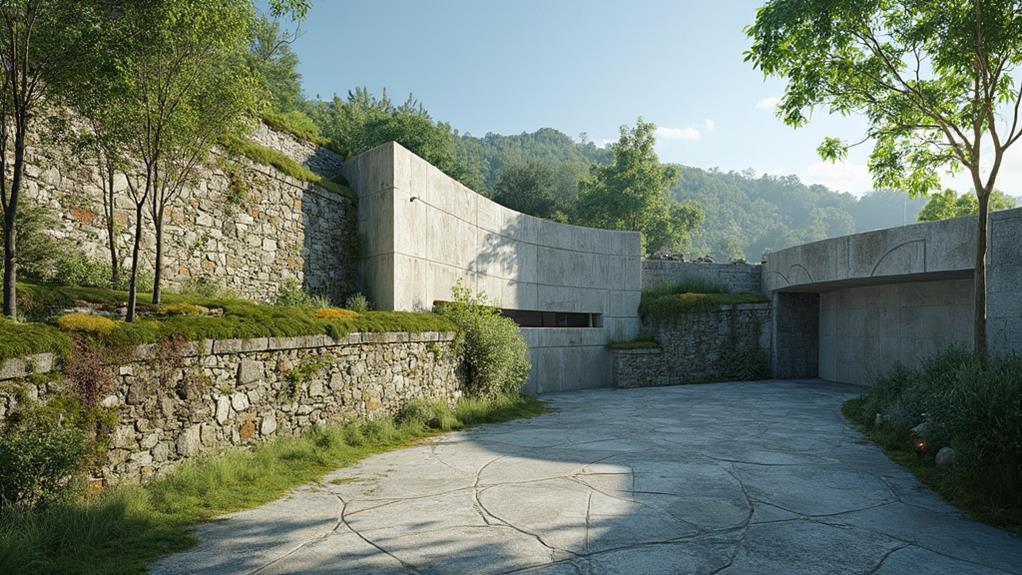The history of retaining wall design techniques extends back to ancient civilizations that adeptly utilized natural materials and foundational engineering principles to construct durable walls. These early structures, often made from locally sourced stone, timber, and earth, demonstrated a profound understanding of soil mechanics, drainage, and gravity. Techniques such as terracing hillsides and applying the batter principle showcased their ingenuity in countering gravitational forces. Over time, retaining wall methods have evolved, incorporating modern materials like reinforced concrete and geosynthetics, enhancing structural stability, aesthetic appeal, and cost-efficiency. Exploring this history reveals the evolution of innovative solutions that continue to shape infrastructure development.
Table of Contents
ToggleWalls Contractor Highlights
- Ancient civilizations developed terracing and gravity wall techniques for land management and stability.
- Early retaining walls utilized local materials like stone, timber, and earth for construction.
- The batter principle and inclined plane were key engineering concepts in early retaining wall designs.
- Dry stone walling and timber crib walls demonstrated ancient craftsmanship without modern tools.
- Ancient engineers incorporated drainage systems to enhance wall durability and erosion resistance.
Earliest Design Innovation

The earliest innovations in retaining wall design are marked by the application of ancient structural methods, which often showcased the impressive utilization of natural materials to accommodate varying geological conditions.
Ancient civilizations ingeniously applied foundational early engineering principles, leveraging materials such as stone, timber, and earth to construct walls that provided both stability and functionality.
Modern companies like Granite Company continue this tradition by utilizing a range of materials including limestone, boulders, and granite for retaining walls. These methods laid the groundwork for future advancements, establishing key techniques that informed the structural integrity and durability of subsequent retaining wall designs.
Ancient Structural Methods
Emerging from the necessity to stabilize terrain and manage landscapes, ancient structural methods of retaining wall design utilized fundamental engineering principles that laid the groundwork for modern techniques. Civilizations such as the Egyptians, Greeks, and Romans demonstrated ingenious approaches, honing the balance between form and function to achieve structural integrity. These early builders relied on simple but effective strategies that capitalized on the physics of load-bearing, creating lasting monuments to human ingenuity.
Among these approaches was the terracing of hillsides, a technique innovatively applied to create arable land in mountainous regions. By strategically cutting into slopes and erecting walls with a backward lean into the earth, engineers counteracted gravitational forces while providing stability. The understanding of soil mechanics and drainage, although rudimentary, was evident in the implementation of stepped designs which disseminated stress and reduced erosion.
In addition, the concept of battering—angling the wall's face—played an indispensable role in resisting lateral pressures. This principle demonstrated an appreciation for durability and foresight, mitigating potential failure. These ancient structural methods display an underlying sophistication, speaking to a timeless human endeavor to harmonize construction with the natural world, fostering a profound sense of belonging within the landscapes they endeavored to tame.
Natural Material Utilization
Ingenious application of natural materials marked the earliest design innovations in retaining wall construction, harnessing what was readily available in the surrounding environment. These early builders displayed remarkable ingenuity, utilizing timber, stone, and earthen materials, fostering a deep connection with their terrain.
Timber, abundant and practical, functioned as the backbone for many early retaining walls, suitable for both forested and less vegetated areas. Logs were skillfully assembled in crisscross patterns, creating crib walls filled with earth or stone to resist the formidable pressure exerted by soil.
Stone, often locally sourced and selected for its durability, was elegantly arranged in dry stone walling techniques. This craftsmanship required precise placement to create structures able to withstand shifting landscapes and periods of high moisture. Additionally, natural earth materials, such as clay and compacted soil, were meticulously layered to form resilient embankments in terrains with suitable soil properties.
This reliance on natural materials not only reflects an attunement to environmental stewardship but also an understanding of materials' strengths and limitations. Through these practices, a balance between function and form was achieved, allowing communities to thrive amidst the challenges posed by slopes and uneven grounds.
Early Engineering Principles
A myriad of early engineering principles laid the groundwork for advanced retaining wall design, transforming rudimentary construction into systematic approaches informed by observation and practical experience. Initially, these principles emerged from ancient civilizations such as Mesopotamia, Greece, and Rome, where early architects recognized the necessity of managing earth pressure to prevent erosion and structural collapse. Through trial and error, early engineers cultivated an understanding of key concepts such as gravitational forces, weight distribution, and material strength.
The evolution of retaining wall design was marked by the development of fundamental techniques such as the inclined plane, which facilitated stability by directing pressure downwards and inwards towards the core of the structure. This methodology was critical in the construction of defensive walls and terraced agricultural systems, both of which remain visible in archaeological sites across these early civilizations.
Equally significant was the incorporation of materials like stone and timber, chosen for their naturally structural properties, which shaped the earliest known engineering solutions. These principles came to formalize the study of geotechnics, ultimately contributing to the sophisticated design standards practiced today. Inextricably linked to the early innovation era, these foundations cultivated a sense of continuity within the engineering community, reverberating across millennia.
Benefits

The evolution of retaining wall design techniques has brought forth numerous benefits, such as enhanced structural stability which guarantees the longevity and safety of infrastructure projects. Boulder walls offer a natural, rustic aesthetic and can be custom-designed to fit various project requirements, providing a unique solution for landscape design.
Furthermore, these designs offer diverse aesthetic options, allowing structures to seamlessly integrate into and enhance the visual appeal of their surroundings while simultaneously optimizing land use to create more functional spaces. Additionally, advancements in design have led to long-term cost efficiency, as modern materials and methods often reduce maintenance needs and extend the lifespan of these essential structures.
Enhanced Structural Stability
When considering the evolution of retaining wall design, reinforced structural stability stands out as a paramount benefit that modern techniques have brought to engineering practices. Over the years, the methodologies employed in constructing retaining walls have seen substantial advancements, primarily driven by the necessity to manage more significant loads while guaranteeing the longevity of structures.
Reinforced structural stability ensures that these walls not only fulfill their primary function of counteracting lateral earth pressures, but also gracefully withstand various environmental challenges, providing long-term security and resilience.
Incorporating materials like geosynthetics, reinforced concrete, and mechanically stabilized earth, contemporary designs contribute enormously to the structural integrity of retaining walls. These innovations not only improve the load-bearing capacity but also enhance flexibility and adaptability, catering to diverse terrains and environmental conditions. The precise calculation and application of forces within these modern designs promote equilibrium and mitigate potential adverse effects like overturning or sliding.
Moreover, by leveraging advanced computational modeling and simulation techniques, the predictability of performance under varied stress scenarios becomes more robust, fostering confidence among engineers, developers, and communities. In this way, reinforced structural stability of modern retaining walls embodies a critical component in constructing safer, more sustainable spaces that foster a sense of belonging within communities.
Aesthetic Design Options
Innovative retaining wall designs extend beyond functionality to embrace aesthetic appeal, marking a pivotal shift in landscape and architectural planning. This evolution responds to an increasing desire for environments that are not only utilitarian but also visually engaging and harmonious with natural surroundings. The benefits of aesthetically thoughtful retaining walls are manifold, fostering a deeper connection between individuals and their environment.
One of the primary advantages is the ability to seamlessly blend structures into the landscape, enhancing both the visual and emotional experience of a space. This integration creates a sense of continuity, elevating the overall ambiance and instilling a feeling of calm and order. Various materials such as natural stone, timber, or textured concrete allow for diverse design expressions, meeting the unique preferences of communities and property owners.
Furthermore, aesthetically designed retaining walls can become focal points in gardens or urban settings, adding layers of interest and sophistication. By employing patterns, curves, and varying heights, these walls invite interaction and contemplation, fostering a sense of place and belonging. They not only serve structural purposes but also celebrate the art of design, contributing to a cohesive and inviting space that resonates with people on a personal level.
Improved Land Utilization
Maximizing space within a given area stands as a key advantage of retaining wall design, particularly when dealing with uneven terrain. This engineering marvel enables optimal utilization of land by effectively transforming slopes into usable flat surfaces. By facilitating the conversion of previously inaccessible areas into functional land, retaining walls contribute significantly to enhancing property utility. Additionally, they play a pivotal role in landscape architecture, allowing homeowners and developers to innovate and maximize aesthetic potential within confined spaces.
Retaining walls achieve improved land utilization by preventing soil erosion and stabilizing slopes, consequently creating additional space suitable for construction or other purposes. For agricultural or residential developers, this not only enhances the acreage of usable land but also secures sustainable environmental management. Integrating retaining walls in urban planning projects creates opportunities for greenery and recreational spaces in otherwise challenging topographies.
Furthermore, such structures enhance property value by making previously overlooked land viable for diverse applications. Landscaping designs can flourish upon these newly leveled grounds, fostering a collective sense of creativity and cohesion within the community. Ultimately, the strategic implementation of retaining walls serves as a crucial tool in addressing spatial challenges, aligning land development with both environmental stewardship and community aspirations.
Long-term Cost Efficiency
Retaining walls offer significant long-term cost efficiency by reducing maintenance expenses and prolonging infrastructure lifespan. These structures are engineering marvels designed to hold back soil and prevent erosion, ultimately minimizing land and building damage. Over decades, design advancements have yielded superior materials and innovative construction techniques that enhance durability and stability, resulting in lower maintenance requirements.
The financial savings derived from investing in retaining walls extend beyond immediate project costs, affording a broader economic and environmental benefit for communities.
- Durability and Resilience: Modern retaining walls are constructed using materials such as reinforced concrete and geosynthetics, which withstand environmental stressors, reducing repair frequency and prolonging the structure's lifetime.
- Versatile Design Solutions: With customizable solutions, retaining walls cater to diverse landscapes and project needs, ensuring effective land management while minimizing future modification costs and disruptions to surrounding areas.
- Erosion and Flood Prevention: By mitigating soil erosion and managing water flow, retaining walls protect adjacent land and infrastructure, reducing erosion-related repair expenses and insurance costs over the long term.
The strategic implementation of retaining walls fosters a sense of security and belonging within communities, ensuring the safeguarding of treasured landscapes and infrastructure for generations to come.
Gravity Walls in Ancient History

Throughout ancient history, gravity walls were constructed using locally available materials, such as stone and raw earth, demonstrating remarkable ingenuity in their design and implementation. These early constructions employed sophisticated engineering methods that relied on the wall's weight to resist soil pressure, showcasing an understanding of foundational principles that still hold value today. Their durability and longevity are evidenced by the enduring presence of these structures in various archaeological sites, serving as a testament to the advanced engineering skills of ancient civilizations.
| Aspect | Description |
|---|---|
| Early Construction Materials | Stone, raw earth |
| Ancient Engineering Methods | Weight-based resistance |
| Durability | Long-lasting presence |
| Longevity Factors | Execution of applications |
Early Construction Materials
Although the concept of retaining walls might seem modern, their origins can be traced back to ancient civilizations that skillfully utilized gravity walls to manage and manipulate landscapes. These structures were crafted from entirely natural early construction materials, reflecting an inherent connection to the environment those societies inhabited. The materials selected were typically abundant, enduring, and remarkably effective for the needs of the time.
The most prolific material, stone, was used due to its inherent durability and availability in various regions. It lent these early gravity walls a robust quality that allowed them to withstand the test of time, protecting human settlements from erosion and landslides.
In tandem with stone, earth and clay played a pivotal role, particularly in regions where stone was less accessible. Compacting these materials provided the necessary stability and cohesion to support tiered agricultural practices.
Wood was occasionally employed, albeit less resistant to decay. Its flexibility and ease of use favored rapidly constructed solutions where immediacy was paramount.
The proficient use of these materials by our ancestors underscores a collective ingenuity, born from an intimate understanding of the natural world and communal interdependence, foundations upon which our own modern infrastructures are built.
Ancient Engineering Methods
Engineering advancements in ancient civilizations exemplified sophisticated understanding of gravity wall construction, techniques central to managing environmental challenges effectively. These early societies astutely harnessed the simple yet powerful concept of gravity to design enduring structures, serving both protective and agricultural purposes. The art of constructing gravity walls, where the weight of sizeable stones held the wall intact, was prevalent from Mesopotamia to the Incan Empire.
The Ancient Greeks perfected the use of dry stone, a method still employed today where stones are carefully balanced without mortar, creating a resilient barrier against natural elements. The practicality of gravity walls lay in their versatile application, evidenced by their presence across diverse terrains and climates. The Romans, renowned for their engineering prowess, integrated gravity walls into expansive infrastructure, including roads and aqueducts. Their legacy demonstrates a keen understanding of materials and topography, allowing for structures that withstood both time and pressure.
Adopted and adapted globally, these walls reflect a universal architectural language guaranteeing functionality. The ancient methods of stone selection and strategic placement emphasized harmony with the surroundings, paralleling modern sustainable practices. Ancient engineers' mastery of gravity walls underscores their ingenuity and foresight, achievements that still resonate in contemporary engineering pursuits.
Durability and Longevity Factors
Within the domain of ancient construction, the durability and longevity of gravity walls were chiefly influenced by meticulous material selection and skilled craftsmanship. These structures, primarily functioning to retain soil or support monumental edifices, relied on the inherent stability provided by gravity. The ancient builders' profound understanding of engineering principles and material properties laid the foundation for the enduring strength of these walls, revered across centuries for their steadfastness in various climatic conditions.
Key factors contributing to the durability and longevity of these ancient gravity walls include:
- Material Selection: Builders utilized locally available stone, selected for its density and resistance to weathering. Granite and limestone were often preferred due to their considerable compressive strength, which supported the colossal weight of these walls.
- Construction Techniques: Masonry skills were paramount, involving interlocking stones with precision to maximize structural stability. The absence of mortar in some cases demanded exactitude in placing each stone, guaranteeing the wall's integrity through friction and mass alone.
- Design Adaptation: Designs were often adapted to suit the local topography and environmental conditions, incorporating features such as drainage systems to mitigate erosion and maintain structural soundness over time.
Such practices guaranteed these architectural marvels continue to stand, symbolizing a lasting legacy for future generations.
Walls Contractor FAQ
How Have Retaining Wall Materials Evolved Over the Centuries?
Retaining wall materials have shifted from natural stone to engineered solutions, embracing the strengths of concrete, geosynthetics, and sustainable materials. This evolution reflects our collective drive towards innovation, resilience, and environmental responsibility in construction practices.
What Role Did Cultural Influences Play in Retaining Wall Design?
Cultural influences markedly shaped retaining wall design by infusing regional aesthetics, available local materials, and traditional construction methods. These elements integrated community identities, fostering a sense of belonging and continuity in the built environment across generations.
How Did Ancient Civilizations Calculate Forces Impacting Retaining Walls?
Ancient civilizations analyzed retaining wall forces using empirical observations, practical construction experience, and geometric intuition. Incorporating shared community knowledge, they effectively managed forces through trial and error, contributing to a collective cultural heritage in engineering principles.
What Innovations Spurred the Modernization of Retaining Wall Techniques?
The modernization of retaining wall techniques was propelled by advancements in materials science, geotechnical engineering, and computer modeling. These innovations enabled more efficient designs, enhanced durability, and stronger structural integrity, fostering a shared commitment to safety and reliability in construction.
How Have Modern Retaining Wall Designs Incorporated Sustainability Practices?
Modern retaining wall designs embrace sustainability by utilizing recycled materials, incorporating vegetation for erosion control, and optimizing drainage solutions. These practices guarantee ecological harmony while maintaining structural integrity, fostering a sense of community responsibility and environmental stewardship.







